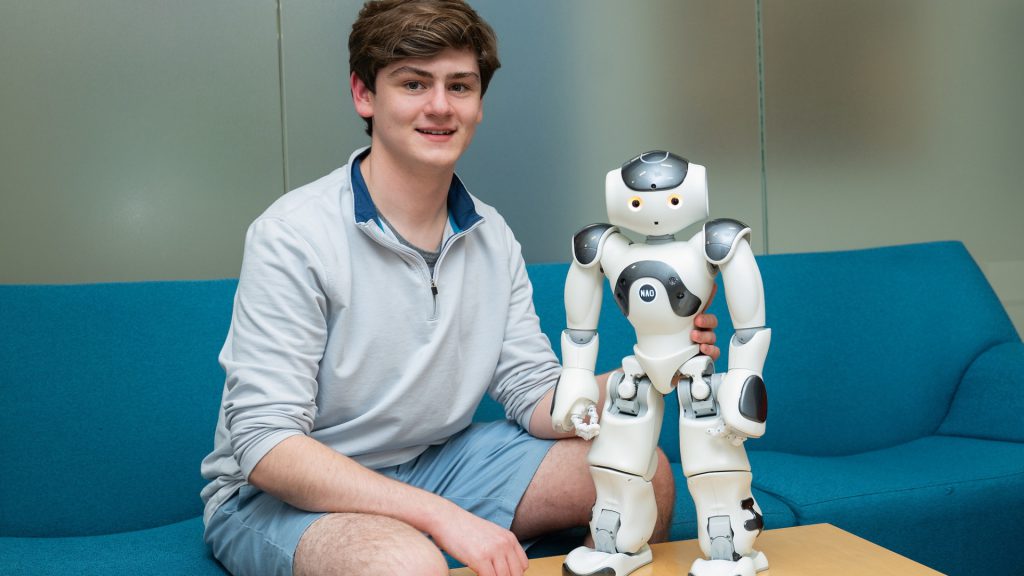Contact:
Mike Ferlazzo
570-577-3212
570-238-6266 (c)
mike.ferlazzo@bucknell.edu
LEWISBURG, Pa. (July 24, 2024) – Getting an early start on college-level research usually means joining a lab after a few weeks on campus. But Sean O’Connor ’26 was invited to join a Bucknell research team while still in high school. While visiting campus on Admitted Student Day as a high school senior from Miller Pace, N.Y., O’Connor attended a mock class with Professor Felipe Perrone, computer science, who invited him to join his research group. “I thought he was kidding at first,” O’Connor says. “But when I arrived on campus to start classes, he asked me to join a research meeting, and I’ve been working with him ever since.”
O’Connor says his “whole life is robotics.” He’s inspired by the potential robots have to positively impact society. His father was a first responder in the 9/11 terrorist attacks and was exposed to highly toxic chemicals and hazardous materials. O’Connor imagines a world in which people are protected from that kind of dangerous work and health risks. “A robot could have detected what was in there or done some cleanup, done the things that these people were doing, and they wouldn’t have gotten hurt,” he says.
His passion has shaped his coursework at Bucknell. As a sophomore, he was granted permission to take junior and senior-level classes to support his research.
That research focuses on developing a human-robot interaction platform called HRIStudio, which aims to make robotics hardware accessible to those outside the computer science field.
Human-robot interaction (HRI) is an emerging field that aims to develop human-robot interactions that are efficient and acceptable to humans. The research involves the study of human attitudes and behaviors. To gain diverse perspectives, O’Connor and Perrone started RoboLab, an on-campus group of students and faculty interested in HRI. “We need all the different disciplines,” O’Connor says. In their weekly meetings, the group discusses robotics-related media — their conversations cover everything from Blade Runner and Warhammer 40,000 (a war game) to questions like, “At what point do humans not want to interact with a robot?” (Answer: when the robot looks too human, unless it’s so good that you can’t tell the difference).
In his free time, O’Connor applies his computer science knowledge to interdisciplinary projects. That’s how he became president of the Chem-E Car Club, a group that builds small, chemically powered vehicles and competes against other schools. He’s also developed software for a kettle sensor that will assist Bucknell’s Coffee Club in its pursuit of the perfect cup, even though he doesn’t drink coffee. “I just keep saying yes to things!” he says.
However, the projects aren’t random; O’Connor sees the parallels between them and his major. “I came to the computer science & engineering major because I saw it as a mix between hardware and software,” he says. “I prefer making things talk to each other and figuring out how to get those sensors and actuators to work as a full system rather than just independent pieces.”
Despite his heavy on-campus commitments, O’Connor was able to embark on a study-abroad opportunity. In the summer after his sophomore year, O’Connor and a group of Bucknell engineers traveled through Italy and France, following Leonardo Da Vinci’s life path while experiencing different languages and cultures. They studied Da Vinci’s scientific worldview, which made him an exceptional artist and engineer, and observed how international engineers approach problems.
Now, O’Connor sees graduate school in his future so he can continue his research, a path he didn’t anticipate when he chose Bucknell. “Working here and having all these resources has completely changed my perspective,” he says.
-30-
To download full image, right-click and choose “save image as”


